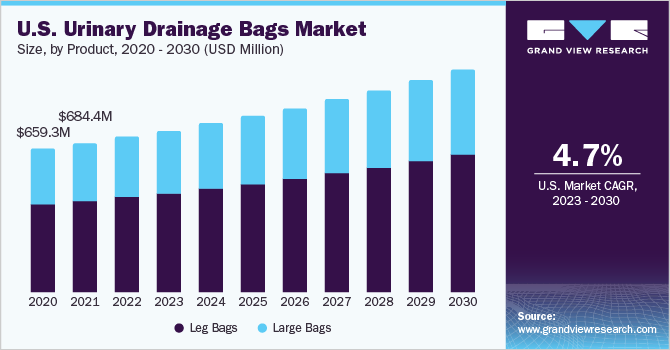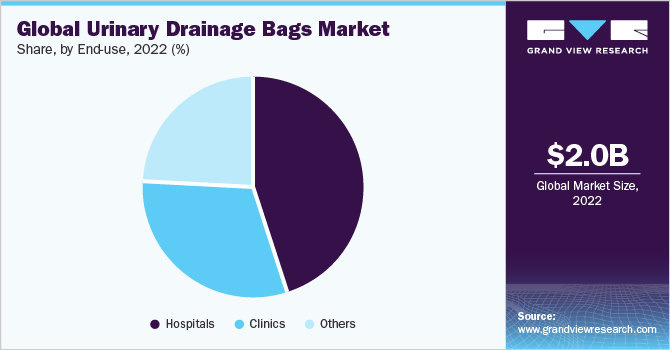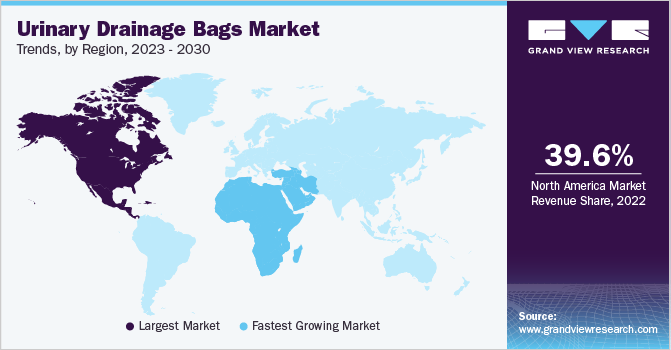- Home
- »
- Medical Devices
- »
-
Urinary Drainage Bags Market Size And Share Report, 2030GVR Report cover
![Urinary Drainage Bags Market Size, Share & Trends Report]()
Urinary Drainage Bags Market Size, Share & Trends Analysis Report By Product (Large Bags, Leg Bags), By Usage (Reusable, Disposable), By Capacity (0-500 Ml, 500-1000 Ml, 1000-2000 Ml), By End-use, By Region, And Segment Forecasts, 2023 - 2030
- Report ID: GVR-4-68039-013-5
- Number of Report Pages: 110
- Format: PDF, Horizon Databook
- Historical Range: 2018 - 2021
- Forecast Period: 2023 - 2030
- Industry: Healthcare
Report Overview
The global urinary drainage bags market size was valued at USD 2.01 billion in 2022 and is anticipated to grow at a compound annual growth rate (CAGR) of 4.9% from 2023 to 2030. A rapid rise in the geriatric population, which is prone to urinary infections, is one of the key factors driving the growth of the market over the forecast period. Aging leads to reduced bladder capacity, feeling of fullness, reduced pelvic floor muscle resistance, reduced rate of detrusor muscle contraction & elevated residual urine volume. Moreover, the geriatric population also faces bladder control issues, such as Urinary Incontinence (UI), leakage, and chronic kidney disease (CKD).

Urinary incontinence is a common problem among persons aged 60 years and above, according to the WHO. According to the same source, the geriatric population across the globe is anticipated to increase from 9.3% in 2020 to 16.0% in 2050. Furthermore, according to a study published in the BMC Geriatrics journal, the prevalence of incontinence among elderly women in Egypt (2020) is expected to be around 80%. The increasing prevalence of end-stage renal diseases due to the rising cases of hypertension and diabetes will also drive the market. According to the report published by the WHO in 2023, around 1.28 billion people who are aged 30-79 worldwide have hypertension.
Diabetes is the primary cause of advanced renal failure, followed by hypertension. According to the report published by the Centers for Disease Control and Prevention (CDC) in 2022, around 37.3 million Americans (1 in 10) have diabetes. Moreover, as per the WHO estimates, in 2019, around 1.5 million deaths were directly caused by diabetes. The increasing prevalence of urological disorders, such as urinary retention, cystitis, benign prostatic hyperplasia, urinary incontinence, and kidney stones, which lead to bladder dysfunction are also among the major factors that will boost product demand.
Urinary incontinence is one of the major medical conditions, in which, urinary drainage bags play a key role in collecting urine, especially in bedridden patients or patients with limited mobility. UI is the most common condition in men and women across the world. For instance, as per the National Health Service (NHS) England, around 61% of the male population and around 34% of women are suffering from lower urinary tract conditions.
Furthermore, according to Phoenix Physical Therapy, 200 million people are affected by UI worldwide. Thus, the rising incidence of urological dysfunctions and related surgeries has augmented the product demand for post-operative convenience. Increasing initiatives by various nonprofit organizations and private players to raise awareness regarding incontinence care are also expected to boost product demand across the globe. The World Federation of Incontinence Patients (WFIP) with the approval of the International Incontinence Society introduced “World Continence Week”. This global-level initiative helps spread awareness about bladder weakness, UI, and other conditions.
In addition, the Centers for Medicare and Medicaid Services in the U.S. issued guidelines for UI care in nursing homes and offered staff web-based instructions. Similarly, the Bladder and Bowel Foundation and Education & Resources for Improving Childhood Continence (ERIC) collaborated to launch the “Love Your Gusset” awareness campaign, which aimed at increasing awareness about the stress UI in women. The management of incontinence care is projected to be simplified as a result of these approaches. As a result of increased awareness and the adoption of appropriate reimbursement rules, expenditures in R&D to create cost-effective and novel drainage bags are likely to increase.
The COVID-19 pandemic has posed numerous obstacles to the global healthcare industry. Inadequate medical facilities for patients with various diseases resulted from limited access to medical care. Due to the lack of immunity, the elderly and patients with various comorbidities were at a higher risk of contracting COVID-19.
Many patients have adopted online counseling for their health-related concerns. Many market players are launching platforms to provide online counseling and guidance to patients who cannot visit healthcare facilities for treatment. For instance, in India, Friends, the adult diaper brand from Nobel Hygiene launched a new campaign asking everyone to identify the symptoms as they spent more time at home during the lockdown period. This campaign highlights the issue of UI that is faced by the elderly in their families and offers telematics assistance to continue taking care of patients suffering from UI.
Such factors are expected to positively impact product demand during the forecast period. Growing healthcare expenditure is a major concern and private players and governments are constantly striving to curb these costs. With a rise in the baby boomer population and the constant increase in the prevalence of diseases, healthcare expenditure is expected to increase during the forecast period. The growth of home healthcare as a cost-effective alternative to hospital stays is also expected to positively impact the market growth over the forecast period. Moreover, the demand for home healthcare among the aging population is also increasing to avoid visiting healthcare facilities.
Product Insights
Based on product, the global urinary drainage bags market is bifurcated into large bags and leg bags. The leg bags segment dominated with a revenue share of 58.4% in 2022 and is anticipated to grow at the fastest CAGR of 5.0% during the forecast period. The segment growth is majorly driven by the rising prevalence of urinary incontinence and increasing hospital admissions across the world. Urinary leg bags are generally preferred by most patients as they allow free movement and are very easy to use.
These bags are compact and easy to stow on the legs. All sorts of indwelling catheter users can benefit from the leg bags. Urinary leg bags are available in a variety of styles, giving users many alternatives to choose from depending on their needs. This product is offered by a number of significant players, which is also projected to drive segment growth. Moreover, several disadvantages associated with the large size bags, such as large size, improper fittings, and low availability of the products, may drive the segment growth over the forecast period. In 2021, CathWear produced a new undergarment that was Medicare-approved which enables easy management of leg bags and includes easy drain without removing them.
Usage Insights
The disposable urinary drainage bags segment dominated the global market in 2022 and accounted for the largest share of 58.8% of the total revenue. The segment is anticipated to grow at a CAGR of 4.9% retaining the leading position throughout the forecast period. Disposable bags are highly preferred by users as they are easy to handle and use. In the case of reusable drainage bags, proper disinfection and cleaning as per the FDA guidelines are very much necessary to avoid the transmission of any kind of infection from one patient to another.
The risk of infection transmission is comparatively less in the case of disposable products owing to which, these products are mostly preferred by healthcare professionals. Various key players offer disposable bags, which is also anticipated to propel the segment growth over the forecast period. For instance, Peeschute, an India-based company, launched eco-friendly unisex paper-based disposable urine bags for helping people relieve themselves at a very low cost.
Capacity Insights
Based on capacities, the global market has been further categorized into 0-500 ml, 500-1000 ml, and 1000-2000 ml. The 500-1000 ml capacity segment accounted for the maximum revenue share of 43.5% in 2022 and is expected to grow at the fastest CAGR of 5.3% over the forecast period. Urinary leg drainage bags with a capacity of 500-1000 ml are the most popular size and one of the most important elements driving this category’s growth is an increase in the demand for leg bags. The 500-1000 ml capacity urinary drainage bags have several advantages owing to which, they are mostly preferred by healthcare professionals as well as patients. They allow free movement and can be easily carried by patients without any feeling of heaviness.
However, the wearer has to frequently change the bags due to the low storage capacity. This may restrain the segment growth to some extent over the forecast period. In addition, high admission rates in hospitals and clinics along with technological advancements that help prevent the introduction of bacteria into the closed indwelling urinary catheter system are also among the major factors expected to boost the segment growth over the forecast period. A rise in the number of government initiatives to spread awareness about urological diseases, such as UI, and the usage of urinary drainage bags, are expected to have a positive impact on the segment growth.
End-use Insights
The hospitals segment accounted for the largest revenue share of 44.6% in 2022 and is expected to grow at the fastest CAGR of 5.2% during the forecast period. The increasing number of surgical procedures performed and rising cases of end-stage renal diseases are the major driving factors for the segment. As per U.S. Renal Data System 2020 Annual Data Report, around 786,000 people in the U.S. had end-stage kidney disease, with 71% on dialysis & 29% with a kidney transplant. In addition, in September 2021, as per the National Institute of Diabetes and Digestive and Kidney Diseases, almost 1 in 5 people with hypertension & 1 in 3 people with diabetes had kidney disease.

Older patients generally require urinary drainage bags on hospital admissions to avoid frequent movement, which is expected to drive the segment growth during the forecast period. Moreover, the rising number of urological procedures and therapies is one of the major driving factors for segment growth. After the completion of any surgery, constant monitoring and care are necessary, owing to which the demand for hospital admissions is increasing. In addition, as per the Statistical Centers of National Spinal Cord Injury “Figure and Facts at a Glance 2020”, around 294,000 people are living with Spinal Cord Injury (SCI), and approximately 17,810 people are diagnosed with SCI each year in the U.S. Hospitals offer effective patient care, offer extensive services and maintain a safe environment.
Regional Insights
North America dominated the global market in 2022 with a revenue share of 39.6% and is expected to witness a significant CAGR during the forecast period. The growth is mainly driven by the rising incidence of targeted diseases, such as bladder cancer, bladder obstruction, urinary retention, UI, and Benign Prostate Hyperplasia (BPH). As per the Canadian Cancer Society, in 2022, around 13,300 people were diagnosed with bladder cancer, and 2,500 people died due to bladder cancer. Thus, an increasing number of BPH-related surgical procedures and rising cases of bladder cancer are driving regional market growth.

Middle East & Africa, on the other hand, is anticipated to register the fastest CAGR of 5.9% during the forecast period due to the wide range of opportunities present throughout this region & as compared to conventional urology medical equipment such as Foley Catheters, etc. This is further expected to boost demand for urinary drainage bags among hospitalization or nursing home visits along with medical clinic visits instead of conventional urological surgical procedures, resulting in shorter hospital stay for patients.
Key Companies & Market Share Insights
Companies are focusing on implementing extensive growth strategies, such as increasing product differentiation and portfolio diversification, expanding marketing & distribution channels, and forming strategic alliances, to improve their product reach and gain a competitive advantage. To strengthen their position in the market, key players are also using other methods, such as acquisitions & mergers, alliances, and new product releases.
For instance, in July 2021, Amsino Medical Group opened a new manufacturing facility in Aurora, which will help the company expand its customer base. In November 2022, Coloplast launched its SpeediCath Flex Set catheter in the U.S. for people with urinary & bladder problems. The SpeediCath Flex Set is offered as a combination of catheter & bag which is also known as a Closed System with an omnidirectional tip & a “no touch dry sleeve”. All these catheters have a triple-action coating technology, which is a choice for people with spinal cord injuries (SCI) and is expected to reduce the risk of urinary tract infections (UTIs) & urethral damage. Some prominent players in the global urinary drainage bags market include:
-
ConvaTec, Inc.
-
Cardinal Health
-
Teleflex, Inc.
-
Coloplast
-
BD (C. R. Bard, Inc.)
-
McKesson Medical Surgical, Inc.
-
Amsino International, Inc.
-
Flexicare Medical Ltd.
-
Medline Industries, Inc.
-
Manfred Sauer GmbH
Urinary Drainage Bags Market Report Scope
Report Attribute
Details
Market size value in 2023
USD 2.1 billion
Revenue Forecast in 2030
USD 2.9 billion
Growth rate
CAGR of 4.9% from 2023 to 2030
Base year for estimation
2022
Historical data
2018 - 2021
Forecast period
2023 - 2030
Quantitative units
Revenue in USD million and CAGR from 2023 to 2030
Report Coverage
Revenue forecast, company ranking, competitive landscape, growth factors, and trends
Segments Covered
Product, usage, capacity, end-use, region
Regional scope
North America; Europe; Asia Pacific; Latin America; MEA
Country scope
U.S.; Canada; UK; Germany; France; Italy; Spain; Denmark; Sweden; Norway; China; Japan; India; Australia; South Korea; Thailand; Brazil; Mexico; Argentina; Saudi Arabia; South Africa; UAE; Kuwait
Key companies profiled
ConvaTec, Inc.; Cardinal Health; Teleflex, Inc.; Coloplast; BD; McKesson Medical Surgical, Inc.; Amsino International, Inc.; Flexicare Medical Ltd.; Medline Industries, Inc.; Manfred Sauer GmbH
Customization scope
Free report customization (equivalent up to 8 analyst’s working days) with purchase. Addition or alteration to country, regional & segment scope
Pricing and purchase options
Avail customized purchase options to meet your exact research needs. Explore purchase options
Global Urinary Drainage Bags Market Report Segmentation
This report forecasts revenue growth at global, regional, and country levels and provides an analysis of the latest industry trends in each of the sub-segments from 2018 to 2030. For this study, Grand View Research has segmented the global urinary drainage bags market report based on product, usage, capacity, end-use, and region:
-
Product Outlook (Revenue, USD Million, 2018 - 2030)
-
Large Bags
-
Leg Bags
-
-
Usage Outlook (Revenue, USD Million, 2018 - 2030)
-
Reusable
-
Disposable
-
-
Capacity Outlook (Revenue, USD Million, 2018 - 2030)
-
0-500 ml
-
500-1000 ml
-
1000-2000 ml
-
-
End-use Outlook (Revenue, USD Million, 2018 - 2030)
-
Hospitals
-
Clinics
-
Others
-
-
Regional Outlook (Revenue, USD Million, 2018 - 2030)
-
North America
-
U.S.
-
Canada
-
-
Europe
-
UK
-
Germany
-
France
-
Italy
-
Spain
-
Sweden
-
Norway
-
Denmark
-
-
Asia Pacific
-
China
-
Japan
-
India
-
Australia
-
Thailand
-
South Korea
-
-
Latin America
-
Brazil
-
Mexico
-
Argentina
-
-
Middle East and Africa
-
Saudi Arabia
-
South Africa
-
UAE
-
Kuwait
-
-
Frequently Asked Questions About This Report
b. The global urinary drainage bags market size was estimated at USD 2.01 billion in 2022 and is expected to reach USD 2.1 billion in 2023.
b. The global urinary drainage bags market is expected to grow at a compound annual growth rate of 4.9% from 2023 to 2030 to reach USD 2.9 billion by 2030.
b. North America dominated the global urinary drainage bags market with a share of 39.56% in 2022. This is attributable to the rising incidence of targeted diseases, such as Urinary Incontinence (UI), bladder obstruction, urinary retention, Benign Prostate Hyperplasia (BPH), and bladder cancer.
b. Some key players operating in the urinary drainage bags market include ConvaTec Inc, Cardinal Health, Teleflex Incorporated, Coloplast, BD, McKesson Medical Surgical Inc, Amsino International, Inc., Flexicare Medical Limited, Medline Industries, Inc., and Manfred Sauer GmbH.
b. Key factors driving the urinary drainage bags market growth include the increasing prevalence of urologic diseases such as bladder cancer, urinary incontinence, and increasing demand for home care services are among the major factors driving this market’s growth.
Share this report with your colleague or friend.
![gvr icn]()
NEED A CUSTOM REPORT?
We can customize every report - free of charge - including purchasing stand-alone sections or country-level reports, as well as offer affordable discounts for start-ups & universities. Contact us now
![Certified Icon]()
We are GDPR and CCPA compliant! Your transaction & personal information is safe and secure. For more details, please read our privacy policy.
We are committed towards customer satisfaction, and quality service.
"The quality of research they have done for us has been excellent."





